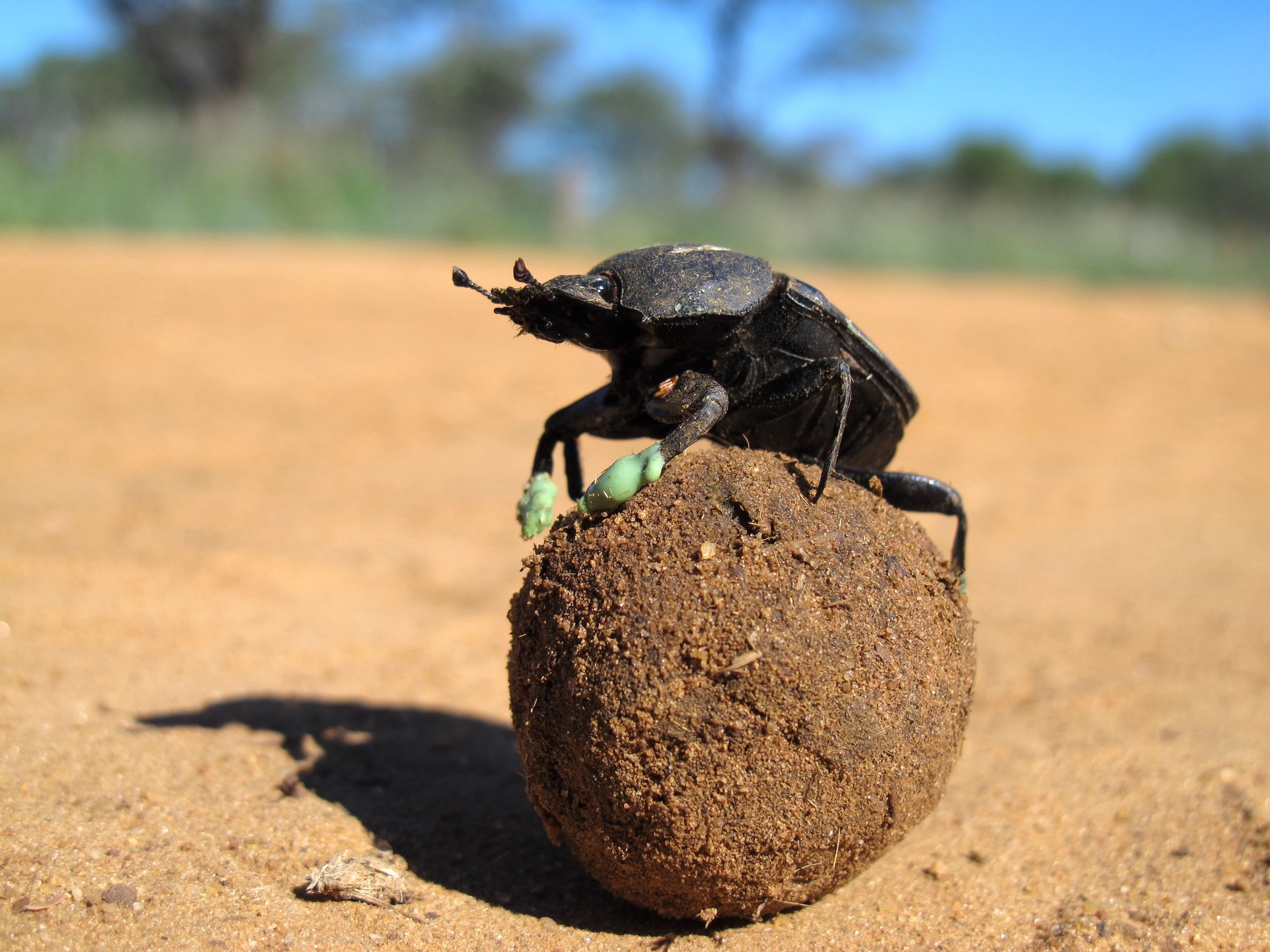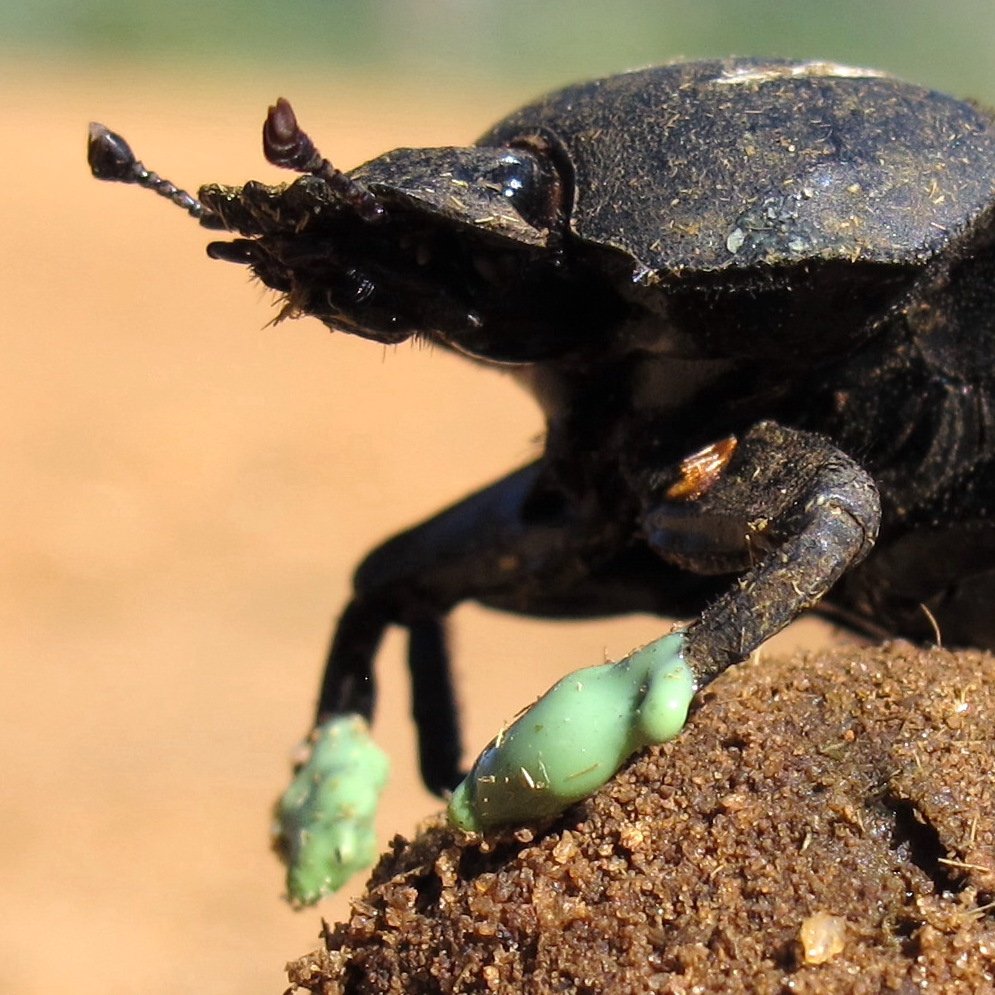2011 | Stonehenge, South Africa
Dung beetle (Scarabaeus lamarcki) heat regulating
Imagine: it’s a hot summer’s day at the beach. Your feet are baking after what feels like hours walking across the hot sand. What could be better than a delicious scoop of cold ice cream, balled up and nestling in a cone?
Today’s post is about exactly that feeling, except instead of ice cream we’re meeting a critter whose favourite food is the droppings of other, much larger animals. And instead of licking that food it simply climbs up on top to cool down. This is the every day life of a tool-using, thermal regulating dung beetle.
Kicking back
We start with a journey to Stonehenge, but not that one. We’re at a game farm with the same name as the famous monument, in the middle of a South African summer. Here, the dung beetles roam free, amidst the African herbivores that dispense beetle food from on high, like giant, gross soft serve machines. It’s also where Jochen Smolka and his colleagues from Lund University in Sweden and University of the Witwatersrand were working to understand the daily routines of these remarkably resilient little beetles.
That routine begins with a dung beetle (of which there are thousands of different species, living on every continent except Antarctica) finding a fresh pile of poop. Wary of other beetles also smelling and snatching away this special prize, the insect quickly uses its specially developed limbs to gather up a sizeable portion of the dung into a heap. As it gathers, it molds the pile into a rough sphere, all the better to roll away. The beetle’s spherical burden is iconic, and it has been noted by humans for thousands of years: ancient Egyptians depicted the sun being rolled across the sky by the scarab beetle deity Khepri.
Here’s one now—the beetle not the god—in its characteristic backwards pose, controlling the dung ball using its back legs, with its head down and front legs doing the power-pushing:
In the past few decades dung beetles have been revealed as one of the animal world’s great navigators. They can use the sun, the wind and even the stars to orient themselves so as to get their smelly payload back to their nest or burrow as efficiently as possible. One of their tricks is what researchers have called the orientation ‘dance’. At the start of their journey, and at other points where they need to recalculate directions, the beetle climbs atop its ball and spins horizontally. Once it has correctly oriented itself, it climbs part-way down off the ball, head first, and pushes off again. If it has aligned itself well, it will take a more or less straight path directly home.
What caught the attention of Smolka and his team was a variation on this dance: they noticed that some beetles climbed up on their ball much more often than seemed necessary for a simple map check. Given the typical dry and hot conditions, the scientists hypothesised that perhaps the tiny animals were overheating, especially the front legs that were typically the only part of the animal in contact with the blistering ground. Resting on their globular baggage would allow them to get some temporary respite.
As a first step, the researchers checked whether increased soil temperatures really did correlate with the beetle hopping up onto its mobile rest. The results were promising, with dung beetles exhibiting much more climbing behaviour as the testing ground heated up from 45 to 60 degrees Celsius. Here’s how the data look, from their 2012 paper:
So far, so good. The next question was whether that resting period actually did help cool the animal. After all, perhaps the ball itself was just as hot as the ground and the beetles were just taking a moment to enjoy a dance atop their poo perch. But again, as predicted, the scientists found that there was a cycle of heating and cooling happening as the beetles went from pushing to climbing positions. The pattern wasn’t evenly distributed either, with the temperature of their front protibia—the technical term for the part of their leg just below the knee, if I can use a bit of blatant anthropomorphism—dramatically affected by the push-climb cycle. The thorax, where the legs and wings attach, was thermally stable in comparison. Another figure from the research paper illustrates the difference:
On average the beetle front legs cooled down by around 7 degrees in just 10 seconds when they climbed off the ground. And if you’re wondering just how the researchers measured temperature so precisely on a moving target, the answer lies in thermal video technology. This is one of the videos the team made as part of its work. You can see how the beetle’s front feet (more anthropomorphism, but you know what I’m referring to) heat up and then drop in temperature every time it stops. The dung ball itself remains consistently cooler than the underlying ground, leaving a little splodge of colour when the beetle starts off again:
Case closed, right? This is textbook tool-use, transporting around an object that (as well as being food and necessary for their newly hatched young) buffers the beetle from a blistering world. Well, what would really solidify the result would be if there was some way to get the beetles to wear insulating footwear. If that led to them not needing to sit about on the dung ball so much, it would establish a direct cause-and-effect link. It’s just a shame that thermal beetle shoes aren’t a thing.
Gloves recommended
Except beetle shoes are a thing, because Smolka’s group invented them. Did you notice that the dung beetle in the image at the top of this post is wearing some? Here’s that same image, cropped to focus on the fancy footwear:
Yet again, the hypothesis was confirmed. The beetles were given tiny removable boots made of dental silicone, and wearing them allowed the same individuals to almost double the amount of time needed between poop stops. Climbing less often allowed them to move more quickly towards their burrow or nest, which after all is the point of collecting the dung in the first place. Their final destination could be up to 85 metres away, so dawdling is not going to help.
In the end, the researchers decided that there could be several factors coming together to make these beetles sit on their balls. The dung acts as both a platform—raising the animal off the hotter ground—and a heat sink that draws the beetle’s body heat into itself, just as it cools the ground when stationary during the rolling cycle. Finally, that cooling effect on the sand probably also helps even when on the move, because the beetle’s legs are walking immediately behind the ball. In fact, the area that the dung has just passed over is on average 1.5 degrees cooler than the surrounding sand. On those long journeys, every degree helps.
As the authors conclude:
Transporting a mobile thermal refuge means that dung beetles do not have to deviate from their chosen path to seek shelter, can cross featureless terrain devoid of any refuges, and are constantly in touch with their ball should the need arise to defend it against conspecifics.
Food for their young, plus a source of protection and comfort in the boiling heat? We may not think much of them, but tool-users don’t have to be anything like us to be well-adapted to their own way of life. Dung balls turned out to be just the cool, squishy technological breakthrough these beetles needed.
Further viewing…
Dung beetles really are fascinating. These are abundant creatures doing an essential environmental clean-up job that often pass completely beneath our notice, despite their extraordinary navigation skills, strength and ability to survive extreme temperatures. If you want to see more—and you should—here are two videos. The first is from the Smithsonian Channel, involving a beetle taking on a huge ball, in a kind of insect strongman display. The second is from Nat Geo Wild, with more details on how these critters collect and fight over their poopy prizes.
Sources: Smolka et al. (2012) Dung beetles use their dung ball as a mobile thermal refuge. Current Biology 22:R863-R864. || Dacke et al. (2021) How Dung Beetles Steer Straight. Annual Review of Entomology 66:243–56. || Krell, F.-T. & A. Moon (2019) Dung beetles. Current Biology 29:R551–R567.
Main image credit: Smolka et al. (2012) || Second image credit: Chris Collingridge; https://www.biozentrum.uni-wuerzburg.de/en/news/archive/news-single/news/not-only-the-wind-shows-the-way-1/ || Third image credit: Smolka et al. (2012) Fig 1A || Fourth image credit: Smolka et al. (2012) Fig 1B || First video credit: LundVisionGroup; https://www.youtube.com/watch?v=1SYgGxc5pho || Second video credit: Smithsonian Channel; https://www.youtube.com/watch?v=xNjymt6oCcQ || Third video credit: Nat Geo Wild; https://www.youtube.com/watch?v=wpUl5_6wBZo




